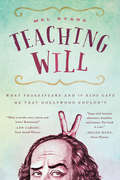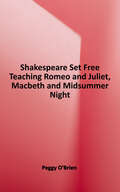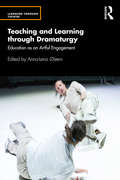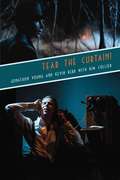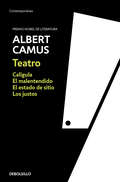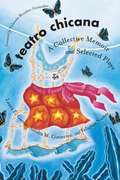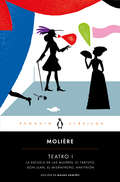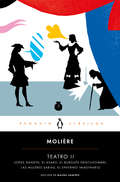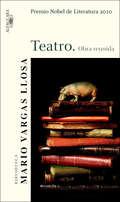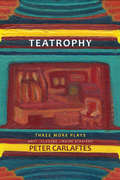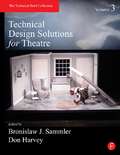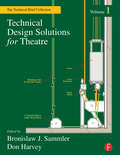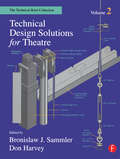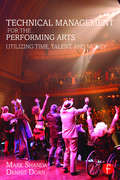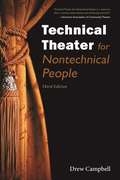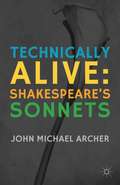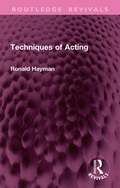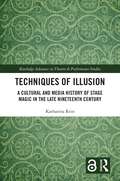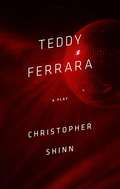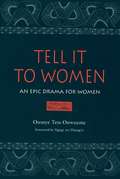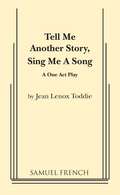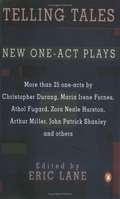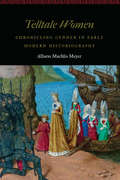- Table View
- List View
Teaching Will: What Shakespeare and 10 Kids Gave Me that Hollywood Couldn't
by Mel RyaneWhat happens when an idealist volunteers to introduce Shakespeare to a group of unruly kids? Bedlam. Tears. And hard lessons learned. Convinced that children can relate to Shakespeare's themes--power, revenge, love--Mel Ryane launches The Shakespeare Club at a public school. Teaching Will is a riotous cautionary tale of high hopes and goodwill crashing into the realities of classroom chaos. Every week Mel encounters unexpected comedy and drama as she and the children struggle toward staging a production of A Midsummer Night's Dream. Woven through this fish-out-of-water tale is Mel's own story of her childhood aspirations, her acting identity, and the heartbreaking end of her onstage career. In the schoolyard, Mel finds herself embroiled in jealousy and betrayal worthy of Shakespeare's plots. Fits of laughter alternate with wiping noses as she and the kids discover a surprising truth: they need each other if they want to face an audience and triumph. Teaching Will is an uplifting story of empowerment for dreamers and realists alike.
Teaching a Midsummer Night's Dream, Romeo and Juliet, and Macbeth: Shakespeare Set Free (Folger Shakespeare Library)
by Peggy O'BrienThe Folger Shakespeare Library, the nation's most important center for Shakespeare study and scholarship, is also the center for Shakespeare education. At the Library's Teaching Shakespeare Institute, scholars, actors, and teachers from across the country work together in the business of teaching and learning Shakespeare. This volume of the Shakespeare Set Free series is written by institute faculty and participants and includes the latest developments in recent scholarship. It bristles with the energy created by teaching and learning Shakespeare from the text and through active performance and reflects the experience, wisdom, and wit of real classroom teachers in schools and colleges throughout the United States. In this book, you will find the following:-Clearly written essays by leading scholars to refresh teachers and challenge older students -Michael Tolaydo’s brilliant and accessible technique for classroom teaching through performance -Day-by-day teaching strategies that successfully and energetically immerse students in every grade and skill level in the language and the plays themselves – created, taught, and written by real teachers.
Teaching and Learning through Dramaturgy: Education as an Artful Engagement (Learning Through Theatre)
by Anna-Lena ØsternThe aim of this book is to contribute a dramaturgical perspective to education. The authors write from a dramaturgical perspective about the planning of teaching, leadership in the classroom, the teacher-body, the teacher’s oral skills and ethics, communication, and about the spaces in which teaching takes place. The book is written with the pre-understanding that the ways in which art creates knowledge need to be illuminated and articulated more clearly in educational thinking, thereby enhancing artful engagement in education. Dramaturgical perspectives are presented as such a way – a form of knowledge that the artform of drama/theatre can contribute to teaching and learning in general. Through examples and analyses of empirical material, as well as through theoretical perspectives, the authors show chapter by chapter how dramaturgy and a dramaturgically inspired language and concepts create more possibilities of choice for teachers in planning and carrying out their teaching. Teaching and Learning through Dramaturgy brings to the forefront what will be enabled in teaching and planning of teaching, by making use of a dramaturgically inspired language and action, what in principle is possible in every subject.
Tear the Curtain!
by Jonathon Young Kim Collier Kevin KerrIn this psychological thriller set in a fictionalized 1930s Vancouver, Alex Braithwaite, a troubled but passionate theatre critic, believes he has found the legendary Stanley Lee, director of the infamous avant-garde theatre "The Empty Space." Alex becomes convinced that this man's radically subversive ideas are what the artistic community of the city needs to shatter audience complacency. In his pursuit of the truth behind Stanley Lee's mysterious disappearance and his artistic ideas, Alex becomes caught between the warring factions of two prominent mob families - one controlling the city's playhouses, the other its cinemas, but both ensnared by the Empty Space Society. At the dawn of the Talkies, can Alex tear through the artifice of these art forms in time to save the city's art community from ripping itself apart?The play's collaborators found inspiration within the walls of Vancouver's Stanley Theatre, a space that has a dual history as a cinema and vaudeville house. Fittingly, this gritty film-noir production became an exploration of the two kinds of art and how they affect the audience. Tear the Curtain! explores global issues that consider what we want from art: to be shocked and surprised or for order to be restored.Cast of 2 women and 8 men.
Teatro
by Albert CamusLa cuatro grandes obras de teatro originales de Albert Camus reunidas en un solo volumen, con un prólogo inédito del autor El presente volumen reúne las cuatro obras de teatro originales de Albert Camus: El malentendido (1944), Calígula (1945), El estado de sitio (1948) y Los justos (1949). Todas pertenecen a lo que podría llamarse el teatro moral o de ideas, relacionado formal y temáticamente con la tragedia clásica, a la que el autor era muy afecto. Sus temas y ambientes abarcan desde el sino trágico de una familia en plena Segunda Guerra Mundial hasta los ataques terroristas de un grupo de revolucionarios rusos, pasando por un brote de peste en una Cádiz imaginaria, o una recreación histórica de los excesos del tirano romano Calígula. Pero Camus sabía que al reflejar momentos históricos todo artista acaba hablando del presente. Así pues, en estas obras escritas a caballo de la Segunda Guerra Mundial encontramos sus preocupaciones habituales sobre el absurdo, la rebeldía, la sociedad y el individuo modernos. El autor ha dicho:«¿Por qué hago teatro? Pues bien, a menudo me lo he preguntado. Y la única respuesta que he podido dar hasta ahora parecerá de una trivilidad descorazonadora: simplemente porque el escenario de un teatro es uno de los lugares del mundo donde soy feliz. El teatro me ofrece la comunidad que necesito [...] Aquí todos estamos vinculados los unos a los otros sin que nadie deje de ser libre o casi: ¿no es una buena fórmula para la sociedad futura?»
Teatro Chicana
by Laura E. Garcia Sandra M. Gutierrez Felicitas NuñezThe 1970s and 1980s saw the awakening of social awareness and political activism in Mexican-American communities. In San Diego, a group of Chicana women participated in a political theatre group whose plays addressed social, gender, and political issues of the working class and the Chicano Movement. In this collective memoir, seventeen women who were a part of Teatro de las Chicanas (later known as Teatro Laboral and Teatro Raíces) come together to share why they joined the theatre and how it transformed their lives. Teatro Chicana tells the story of this troupe through chapters featuring the history and present-day story of each of the main actors and writers, as well as excerpts from the group's materials and seven of their original short scripts.
Teatro I: La escuela de las mujeres / El tartufo / Don Juan / El misántropo / Anfitrión
by MolièreUno de los mayores dramaturgos europeos en una edición magistral a cargo de Mauro Armiño. El presente volumen, primero de dos dedicados al teatro de Molière, reúne cinco de sus grandes comedias, estrenadas entre 1662 y 1668, cuando su compañía conquistó los escenarios de París. En La escuela de las mujeres tuvo su primer gran éxito; con El Tartufo desató el escándalo; en Don Juan enriqueció un nuevo mito europeo; con El misántropo ofreció un agudo análisis de la necedad; y en Anfitrión parodió los entresijos de la corte. En conjunto, estas piezas geniales no solo exponen las flaquezas humanas, sino que castigan con el ridículo a quienes más a salvo se creen de ellas. Nuestra edición, a cargo de Mauro Armiño, uno de los mejores traductores y críticos literarios de la actualidad, se completa con una espléndida introducción, notas explicativas y noticias sobre el contexto histórico-literario de las comedias.
Teatro II: Georges Dandin / El avaro / El burgués gentilhombre / Las mujeres sabias / El enfermo imaginario
by MolièreSegundo tomo de las obras esenciales de Molière, uno de los mayores dramaturgos de la literatura europea, a cargo de Mauro Armiño El presente volumen, con el que completamos nuestra selección del teatro de Molière, reúne cinco de sus grandes comedias, estrenadas entre 1668 y 1673, durante el último lustro de vida del autor. Jorge Dandín castiga los sueños de ascenso social; El avaro ataca la codicia de la burguesía en el siglo xvii; El burgués gentilhombre satiriza los códigos huecos de la aristocracia; Las mujeres sabias pone el punto de mira en la pedantería; y El enfermo imaginario ironiza sobre los límites subjetivos de la salud. En estas piezas tardías, el inigualable comediógrafo amplía su registro hasta alcanzar por momentos el sentimiento trágico de la vida. Nuestra edición, a cargo de Mauro Armiño, uno de los grandes traductores y críticos literarios de la actualidad, se completa con notas explicativas y cuidadas noticias sobre el contexto histórico-literario de las comedias.
Teatro. Obra reunida
by Mario Vargas LlosaLa obra dramatúrgica reunida en un volumen del premio Nobel Mario Vargas Llosa. «El teatro y su imaginería son un género privilegiado para representar el inquietante laberinto de ángeles, demonios y maravillas que es la morada de nuestros deseos.»Mario Vargas Llosa La creación teatral de Mario Vargas Llosa, desconocida para muchos de quienes ya han disfrutado de su narrativa, es parte imprescindible de su carrera y sus inquietudes literarias. Este género le permite ahondar en una de las constantes de su obra: la medida en que las historias que relatamos y nos relatamos, las fantasías con las que pretendemos abrillantar cada día, son una manera de ensanchar nuestra existencia más allá de los límites que impone la realidad cotidiana. La señorita de Tacna (1981), Kathie y el hipopótamo (1983), La Chunga (1986), El loco de los balcones (1993) y Ojos bonitos,cuadros feos (1996), cinco textos dramáticos donde temas tan cardinales para el ser humano como la familia, la vejez, el orgullo, el destino, el amor, los deseos, el machismo, la dinámica entre presente y pasado y la naturaleza del talento creador quedan envueltos por otro: el papel de la ficción en la vida, la rectificación de la vida que obra la ficción.
Teatrophy
by Peter CarlaftesIn Teatrophy: Three More Plays, critically-acclaimed playwright/author/poet Peter Carlaftes offers a trio of brilliant and intense modern plays that inspire on both page and stage. In "Anti,” Carlaftes explores a frightening future-in which government surveillance and data mining is the norm-through the eyes of a theater director on the verge of giving up hope. The chilling psycho-sexual drama "Closure” examines the relationship between a woman whose sister was abused a child, and the rapist-murderer that stalks her outside her therapist’s office. In the tender and humorous "Inside Straight,” characters must confront their lovers’ sudden shift in sexual orientation as a gay man and a lesbian woman discover they are attracted to each other. The San Francisco Bay Guardian praised the play: "Inside Straight is a comedy of eros! . . . A restive heart knows no logic or permanence. ” All three plays share a passion for beautifully drawn, full characters and powerful moments that force them to expose the true identity they work so hard to hide. As the SF Weekly raved, "As with Strindberg, Beckett or even Sartre, Carlaftes’ message seems to be something we intuit, like music. ”
Technical Design Solutions for Theatre Volume 3: The Technical Brief Collection Volume 1
by Bronislaw J Sammler Don HarveyTechnical Design Solutions for Theatre is a collection of single-focus articles detailing technical production solutions that have appeared in The Technical Brief Collection, a publication of the Yale School of Drama’s Technical Design and Production Department. The primary objective of the publication was to share creative solutions to technical problems so that fellow theatre technicians can avoid having to reinvent the wheel with each new challenge. The range of topics includes scenery, props, painting, projections, sound, and costumes. Each article describes an approach, device, or technique that has been tested onstage or in a shop. Great reference of tips and solutions to persistent technical challenges in theatre production Solutions provided by contributors from over twenty different producing organizations Ten years of The Technical Brief Collection articles bound in each of three volumes A comprehensive index to all three volumes included in Volume III
Technical Design Solutions for Theatre: The Technical Brief Collection Volume 1
by Don Harvey Bronislaw J. SammlerThe Technical Brief is a collection of single-focus articles on technical production solutions, published three times a year by the prestigious Yale School of Drama. The primary objective of the publication is to share creative solutions to technical problems so that fellow theatre technicians can avoid having to reinvent the wheel with each new challenge. The range of topics includes scenery, props, painting, electrics, sound, and costumes. The articles each describe an approach, device, or technique that has been tested on stage or in a shop by students and professionals. Some articles included: Growing Flowers on Stage; Break-Away Glass; Photo-Murals for the Stage; Quiet Wire-Rope Curtain Track; Free Standing Curved Stairs; A Measured Approach to Kerfing; A Low-Voltage Remote Controller for Special Effects; Toggle-Clamp Locks; Comparing Four Plastics as Scenery Glides; Low Pressure Air Casters; A Simple Lift Jack; Using a Piano to Create a Reverberation Effect; Horn-Hat Mics for Sound Reinforcement
Technical Design Solutions for Theatre: The Technical Brief Collection Volume 2
by Don Harvey Bronislaw J. SammlerThe Technical Brief is a collection of single-focus articles on technical production solutions, published three times a year by the prestigious Yale School of Drama. The primary objective of the publication is to share creative solutions to technical problems so that fellow theatre technicians can avoid having to reinvent the wheel with each new challenge. The range of topics includes scenery, props, painting, electrics, sound and costumes. The articles each describe an approach, device, or technique that has been tested on stage or in a shop by students and professionals. Some articles included are: Building Authentic Elizabethan Ruffs; Simple and Inexpensive Stained Glass; A Quick-Load Floor Pulley Design; A Simple Approach to Stretching Drops; Flexi-Pitch Escape Stairs; Spot-Welding Scrim with Sobo; Handrail Armatures for a Grand Staircase; The Triscuit-Studwall Deck System; A Frameless Turntable; Stand on Stage: Minimum Weight, Maximum Effect; A Self-Paging Cable Tray; Roller Chain Turntable Drives; A Bench-Built XLR Cable Tester
Technical Design Solutions for Theatre: The Technical Brief Collection Volume 2
by Bronislaw J. SammlerThe Technical Brief is a collection of single-focus articles on technical production solutions, published three times a year by the prestigious Yale School of Drama. The primary objective of the publication is to share creative solutions to technical problems so that fellow theatre technicians can avoid having to reinvent the wheel with each new challenge. The range of topics includes scenery, props, painting, electrics, sound and costumes. The articles each describe an approach, device, or technique that has been tested on stage or in a shop by students and professionals. Some articles included are: Building Authentic Elizabethan Ruffs; Simple and Inexpensive Stained Glass; A Quick-Load Floor Pulley Design; A Simple Approach to Stretching Drops; Flexi-Pitch Escape Stairs; Spot-Welding Scrim with Sobo; Handrail Armatures for a Grand Staircase; The Triscuit-Studwall Deck System; A Frameless Turntable; Stand on Stage: Minimum Weight, Maximum Effect; A Self-Paging Cable Tray; Roller Chain Turntable Drives; A Bench-Built XLR Cable Tester
Technical Management for the Performing Arts: Utilizing Time, Talent, and Money
by Mark Shanda Dennis DornTechnical Management for the Performing Arts: Utilizing Time, Talent, and Money is a comprehensive guide to the tools and strategies of a successful technical manager. This book demonstrates how you can coordinate personnel, raw materials, and venues, all while keeping a production on a tight schedule and within budget. From concept to realization, through nightly performances, Technical Management for the Performing Arts focuses on the technical and organization skills a technical manager must demonstrate, and emphasizes the need for creativity and interpersonal management of a team.
Technical Theater for Nontechnical People: Second Edition
by Drew CampbellTechnical Theater for Nontechnical People helps actors, directors, stage managers, producers, and event planners understand every aspect of technical theater-from scenery, lighting, and sound to props, costumes, and stage management. In this thoroughly revised new edition, the popular guide firmly embraces the digital age with new content about digital audio, intelligent lighting, LED lighting, video projection, and show control systems, all explained in the same approachable style that has kept this book in the pockets of industry professionals for many years. A brand-new chapter on sound design has also been added, and every chapter has been updated with more information about the basics of theater technology, including draperies, lighting instruments, microphones, costume sketches, and more. This book teaches:Who's who on a theatrical production teamWhat is needed to know about technical theater and whyWhat to look for when choosing a space for a showHow to communicate with lighting, scenery, audio, and costume designersHow to stage manage an effective show or presentationCovering both traditional and digitally supported backstage environments, this book is an essential guide for working with every technical aspect of theater!Allworth Press, an imprint of Skyhorse Publishing, publishes a broad range of books on the visual and performing arts, with emphasis on the business of art. Our titles cover subjects such as graphic design, theater, branding, fine art, photography, interior design, writing, acting, film, how to start careers, business and legal forms, business practices, and more. While we don't aspire to publish a New York Times bestseller or a national bestseller, we are deeply committed to quality books that help creative professionals succeed and thrive. We often publish in areas overlooked by other publishers and welcome the author whose expertise can help our audience of readers.
Technically Alive
by John Michael ArcherDrawing on the later writings of Martin Heidegger, the book traces the correspondence between the philosopher's concept of technology and Shakespeare's poetics of human and natural productivity in the Sonnets.
Techniques of Acting (Routledge Revivals)
by Ronald HaymanOriginally published in 1969, this was the first book of its kind: an attempt to describe the different approaches that the actor needs to make to different media – theatre, film and television – and to show how the art of acting, which never stops evolving had entered into a new phase of growth in the sixties. Ronald Hayman examines questions which are basic, but had often been ignored: What exactly goes on inside the actor’s mind while (s)he is preparing a part? How much do actors vary in their approach? Where does personality stop and technique begin? This wide-ranging study of the actor at work is based partly on what outstanding actors have said about their methods but chiefly on close analysis of actual performances in plays, films and on television. Laurence Olivier, Helene Weigel, Jeanne Moreau and many others are both examined in close-up and viewed in perspective against the giants of the past like Bernhardt and Salvini.
Techniques of Illusion: A Cultural and Media History of Stage Magic in the Late Nineteenth Century (Routledge Advances in Theatre & Performance Studies)
by Katharina ReinThis book explores stage conjuring during its “golden age,” from about 1860 to 1910. This study provides close readings highlighting four paradigmatic illusions of the time that stand in for different kinds of illusions typical of stage magic in the “golden age” and analyses them within their cultural and media-historical context: “Pepper’s Ghost,” the archetypical mirror illusion; “The Vanishing Lady,” staging a teleportation in a time of a dizzying acceleration of transport; “the levitation,” simulating weightlessness with the help of an extended steel machinery; and “The Second Sight,” a mind-reading illusion using up-to-date communication technologies. These close readings are completed by writings focusing on visual media and expanding the scope backwards and forwards in time, roughly to 1800 and to 2000. This exploration will be of great interest to students and scholars in theatre and performance studies.
Teddy Ferrara
by Christopher Shinn"Mr. Shinn is among the most provocative and probing of American playwrights today."-The New York Times"Chris Shinn explores politics and ethics without moralizing and finds justice and beauty in intimate life, keenly observed and rendered scrupulously, unapologetically, fearlessly . . . I admire his work enormously."-Tony KushnerWhen a campus tragedy makes national headlines, Gabe, a senior who runs the Queer Students Group, discovers that events surrounding the tragedy aren't as straightforward as they seem. A Pulitzer Prize finalist's searing play about what happens when a tragedy sparks a movement - and the truth gets lost along the way. World Premiere at Chicago's Goodman Theatre in winter 2013.Christopher Shinn's works include Where Do We Live, Four, Other People, What Didn't Happen, On the Mountain, and The Coming World. He has received the Obie Award for playwriting and a Guggenheim Fellowship in Playwriting, and has also been shortlisted for the Evening Standard Theatre Award for Best Play and nominated for an Olivier Award for Most Promising Playwright.
Teen Take Ka Upanyas: तीन टके का उपन्यास
by Bertolt Brecht'तीन टके का उपन्यास' दरअसल बेर्टोल्ट ब्रेष्ट के प्रसिद्ध नाटक ‘थ्री पेनी ऑपेरा’ का ही एक विस्तृत और व्यापक संस्करण है. ‘थ्री पेनी आपेरा’ ब्रिटिश नाटककार जॉन गे द्वारा लिखित ‘बेगर्स ऑपेरा’ पर आधारित था. 1728 में लिखे गये ‘बेगर्स ऑपेरा’ के सभी केन्द्रीय चरित्र जैसे मैकहीथ, पीचम, जेनी, पॉली, आदि ब्रेष्ट के ‘थ्री पेनी ऑपेरा’ में थे. 1928 में ब्रेष्ट ने यह उपन्यास पूरा किया. 1934 में उन्होंने इन्हीं चरित्रों और उसी कहानी को लेकर ‘थ्री पेनी नॉवेल’ यानी ‘तीन टके का उपन्यास’ लिखा. जहाँ नाटक में ब्रेष्ट के पास एक-एक चरित्र को विकसित करने का मौका नहीं था, वहीं उपन्यास में उन्होंने हर चरित्र को पूरी तरह विकसित किया और बोलचाल की भाषा में होने के बावजूद इसे ‘एपिकल’ बना दिया।
Tell It to Women: An Epic Drama for Women
by Ngugi Wa Thiong’o Osonye Tess OnwuemeUsing the magic of movement, dance, and drama, and the devices of humor and metaphor, Osonye Tess Onwueme has created a post-feminist epic drama that transcends current feminist theories. An ideologically and politically powerful work, Tell It to Women offers a critical discourse on the western feminist movement from an African traditional perspective, focusing attention on the often silenced issues of intra-gender politics and class inequities.
Tell Me Another Story, Sing Me a Song
by Jean Lenox ToddiePlay . Jean Lenox Toddie. Characters: 2 female. Bare stage or simple set. . This witty look at mother daughter relationships is a light hearted exploration of irritations and misunderstandings that build walls between a woman and her female off spring-- and the love and compassion that destroys these walls. The crisis and humor of childhood, adolescence, adulthood and old age are evoked in a celebration of dissonance and the harmony between mothers and daughters. With the light touch of fantasy, it touches some of our deepest emotions.
Telling Tales: New One-Act Plays
by Eric LaneAn exciting and varied collection of contemporary one-act plays from some of today’s best playwrights.
Telltale Women: Chronicling Gender in Early Modern Historiography (Women and Gender in the Early Modern World)
by Allison Machlis MeyerTelltale Women fundamentally reimagines the relationship between the history play and its source material as an intertextual one, presenting evidence for a new narrative about how—and why—these genres disparately chronicle the histories of royal women. Allison Machlis Meyer challenges established perceptions of source study, historiography, and the staging of gender politics in well-known drama by arguing that chronicles and political histories frequently value women&’s political interventions and use narrative techniques to invest their voices with authority. Dramatists who used these sources for their history plays thus encountered a historical record that offered surprisingly ample precedents for depicting women&’s perspectives and political influence as legitimate, and writers for the commercial theater grappled with such precedents by reshaping source material to create stage representations of royal women that condemned queenship and female power. By tracing how the sanctioning of women&’s political participation changes from the narrative page to the dramatic stage, Meyer demonstrates that gender politics in both canonical and noncanonical history plays emerge from playwrights&’ intertextual engagements with a rich alternative view of women in the narrative historiography of the sixteenth and seventeenth centuries.
